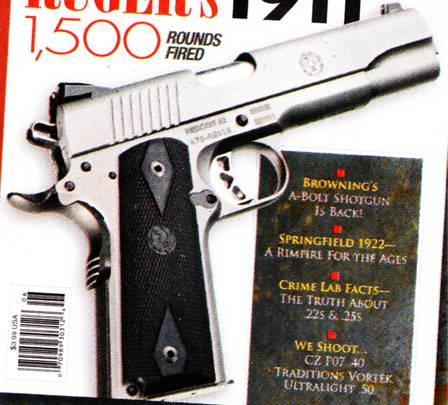The thefirearmblog.com has captured an image of Ruger’s 1911 from an upcoming issue of Guns & Ammo previewed in Shooting Times. And what do we learn from this? Not much, except that Ruger is cashing in on the 1911 mania sweeping gun nation. Then again, there’s not a whole lot you can do with a gun design that was pretty much set in stone 100 years ago. The bottom line will be . . . the bottom line. Remington launched its R1 1911 at a slightly sub-$1k price tag. If Ruger can bring in this bad boy closer to the $500 mark with the same quality, it should be a slam dunk. Oh, and note to Guns & Ammo: please return TTAG’s “The Truth About . . .” tagline when you’re done. Tx.





The rumors are true. I honestly thought that this is what they were going to release when they announced the LC9.
Honestly, I’m not sure why Ruger would distract itself by adding yet another completely new (to them) design to their production and sourcing stream, only to enter an extremely crowded and competetive 1911 market. Especially when they can hardly make enough LCRs and 3″ SP-101s to meet demand.
Wasn’t there an air of inevitability about this though? How could Ruger NOT offer a 1911 it’d be like a car manufacturer ignoring the family sedan.
I just hope it proves to be as rugged, reliable and affordable as many of their other offerings and that they didn’t decide to engineer their own proprietary magazines for it a-la the Mini 14 & 30 (I’m only half joking about that).
Yawn. I really wish they would come out with a design that makes other gun makers say “why didn’t WE think of that?”.
Can someone explain why its taken so long for someone to make a decent 1911 for around 500-600 bucks, Springfield does it with the GI. but lets face it those grips look like my uncle made them in his woodshop out of an old picnic table and charged them .50 cents a piece.
So why are 1911’s so expensive?
The crucial parts of a 1911 require a lot of fairly complex machining, with lots of critical (and very precise) clearances, dimensions, and angles. Metal Injection Molding is cheaper than investment-casting, which is cheaper than machining all the parts from billets. But even with MIM raw parts and CNC mills to finish them, these complex parts take time to machine and measure.
F’r instance, the 1911 uses a swinging barrel link to lower the barrel out of engagement with the slide/breech during cycling. This requires that *four* parts (the barrel, link, pivot pin and takedown pin) be machined separately to mate perfectly. More modern designs reduce this machinist’s headache by using the now-ubiquitous ’tilting block’ barrel engagement lug: it only requires that the barrel lugs mate with the takedown pin, AND it lasts much longer and is easier to replace if you want a new barrel.
The 1911 is similarly complex in its sear/interruptor mechanism, which requires about 60,000 parts (okay, I exaggerate) to mate together perfectly. Even the 1911’s magazine release is a complex and costly part to machine and fit. I don’t know how many discrete cuts have to be made to manufacture it, but I know my P95 requires only one investment-cast lever and a single leaf spring.
Simpler is cheaper, and often more reliable. Antoine de Saint-Exupery said it best: “A designer knows he has achieved perfection not when there is nothing left to add, but when there is nothing left to take away.”
And Springfield’s are built in Brazil. Much lower labor costs.
Gee willikers, another 1911! What’s next, another plastic nine? The world wonders.
How come it’s not the Naked Truth About Guns?
Might be worth considering if they made some kind of change that would make it more durable and last longer. I wouldn’t want a gun that needed major overhaul after a few thousand rounds like is often suggested by hardcore 1911 guys.
Comments are closed.